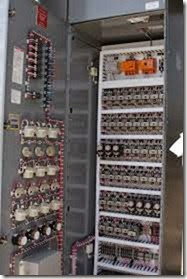Transducer Performance
The operation of a transducer within a control system can be described in terms of its static performance and its dynamic performance. The static characteristics of greatest interest are
✁ Scale factor (or sensitivity)
✁ Accuracy, uncertainty, precision, and system error (or bias)
✁ Threshold, resolution, dead band, and hysteresis
✁ Linearity
✁ Analog drift
The dynamic characteristics of greatest interest are
✁ Time constant, response time, and rise time
✁ Overshoot, settling time, and damped frequency
✁ Frequency response
Static performance is documented through calibration, which consists of applying a known input (quantity or phenomenon to be measured) and observing and recording the transducer output. In a typical calibration procedure, the input is increased in increments from the lower range limit to the upper range limit of the transducer, then decreased to the lower range limit. The range of a component consists of all allowable input values. The difference between the upper and lower range limits is the input span of the component; the difference between the output at the upper range limit and the output at the lower range limit is the output span.
Dynamic performance is documented by applying a known change, usually a step, in the input and observing and recording the transducer output.
Loading and Transducer Compliance
A prime requirement for an appropriate transducer is that it be compliant at its input. Compliance in this sense means that the input energy required for proper operation of the transducer, and hence a correct measurement of the controlled output, does not significantly alter the controlled output. A transducer that does not have this compliance is said to load the controlled output. For example, a voltmeter must have a high-impedance input in order that the voltage measurement does not significantly alter circuit current and, hence, alter the voltage being measured.
Defining Terms
Controlled output: The principal product of an automatic control system; the quantity or physical activity to be measured for automatic control.
Feedback path: The cascaded connection of transducer and signal conditioning components in an automatic control system.
Forward path: The cascaded connection of controller, actuator, and plant or process in an automatic control system.
Motion transducer: A transducer used to measure the controlled output of a servomechanism; usually understood to include transducers for static force measurements.
Plant or process: The controlled device that produces the principal output in an automatic control system.
Process control: The term used to refer to the control of industrial processes; most frequently used in reference to control of temperature, fluid pressure, fluid flow, and liquid level.
Process transducer: A transducer used to measure the controlled output of an automatic control system used in process control.
Reference input: The signal provided to an automatic control system to establish the required controlled output; also called setpoint.
Servomechanism: A system in which some form of motion is the controlled output.
Signal conditioning: In this context, the term used to refer to the modification of the signal in the feedback path of an automatic control system; signal conditioning converts the sensor output to an electrical signal suitable for comparison to the reference input (setpoint); the term can also be applied to modification of forward path signals.
Transducer: The device used to measure the controlled output in an automatic control system; usually consists of a sensor or pickup and signal conditioning components.
References
Bateson, R.N. 1993. Introduction to Control System Technology, 4th ed. Merrill, Columbus, OH.
Berlin, H.M. and Getz, F.C., Jr. 1988. Principles of Electronic Instrumentation and Measurement. Merrill, Columbus, OH.
Buchla, D. and McLachlan, W. 1992. Applied Electronic Instrumentation and Measurement. Macmillan, New York.
Chaplin, J.W. 1992. Instrumentation and Automation for Manufacturing. Delmar, Albany, NY. Doeblin, E.O. 1990. Measurement Systems Application and Design, 4th ed. McGraw-Hill, New York. Dorf, R.C. and Bishop, R.H. 1995. Modern Control Systems, 7th ed. Addison-Wesley, Reading, MA.
O’Dell, T.H. 1991. Circuits for Electronic Instrumentation. Cambridge University Press, Cambridge, England, UK.
Seippel, R.G. 1983. Transducers, Sensors, and Detectors. Reston Pub., Reston, VA.
Webb, J. and Greshock, K. 1993. Industrial Control Electronics, 2nd ed. Macmillan, New York.
Further Information
Manufacturers and vendors catalogs, data documents, handbooks, and applications notes, particularly the handbook series by Omega Engineering, Inc.:
The Flow and Level Handbook
The Pressure, Strain, and Force Handbook
The Temperature Handbook
Trade journals, magazines, and newsletters, particularly:
Instrumentation Newsletter (National Instruments)
Personal Engineering and Instrumentation News
Test and Measurement World
